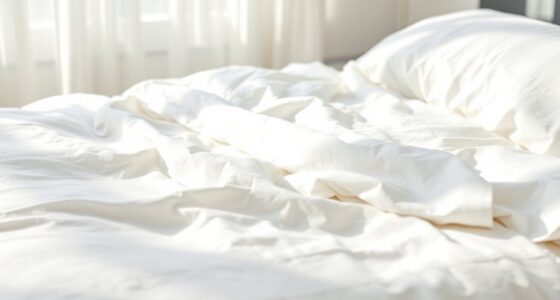Clothes often smell after storage because residual moisture creates a damp environment that fosters bacteria and mold growth. Poor ventilation traps humidity, making it easier for odors to develop and persist. Storage containers and materials that don’t breathe can trap moisture and smells inside. Temperature fluctuations and high humidity levels further boost mold and bacteria activity. To prevent these odors, it’s vital to dry clothes thoroughly, choose proper storage options, and guarantee good airflow—discover how to do this effectively.
Key Takeaways
- Residual moisture in stored clothes creates an environment for bacteria and mold, causing unpleasant odors.
- Incomplete drying traps sweat, oils, and organic residues that microbes break down, producing lasting smells.
- Poor ventilation prevents moisture and odor molecules from escaping, leading to stale, musty smells.
- Non-breathable storage containers trap humidity and odors, intensifying unpleasant smells over time.
- Certain fabrics absorb external odors and retain them when damp, resulting in persistent smells after storage.
The Role of Moisture in Causing Odors

Moisture is a primary factor that causes clothes to develop unpleasant odors during storage. When clothes aren’t completely dry before being put away, residual water creates a damp environment. This moisture provides the perfect setting for odor-causing molecules to thrive. It also makes fabrics more susceptible to absorbing external smells, like mustiness or mildew. Even small amounts of moisture can lead to long-lasting odors if stored improperly. You might notice your clothes smell stale or sour after being stored for a while, especially in humid conditions. To prevent this, ensure your clothes are thoroughly dry before packing them away. Using airtight containers or adding moisture absorbers can also help keep your clothes fresh during storage. Proper ventilation and understanding fabric properties can further reduce the risk of odors developing over time.
Bacterial and Mold Growth in Stored Clothing

When clothes aren’t completely dry before storage, they become a breeding ground for bacteria and mold. Moisture trapped in fabric creates ideal conditions for these microorganisms to thrive. Bacteria can produce unpleasant odors as they break down sweat, oils, and other organic materials left on your clothing. Mold, on the other hand, develops in damp environments, forming fuzzy patches that emit a musty smell. These microorganisms not only cause odors but can also weaken fabric fibers over time. If you store damp clothes, you’re allowing bacteria and mold to multiply unchecked. To prevent this, always make certain your clothes are thoroughly dry before putting them away. Proper drying kills most bacteria and mold spores, reducing the risk of unpleasant smells developing during storage. Additionally, using antimicrobial treatments can help inhibit microbial growth on fabrics.
Effects of Inadequate Ventilation on Clothing Freshness

Inadequate ventilation can considerably impact your clothing’s freshness after storage. Without proper airflow, moisture gets trapped inside your wardrobe or storage bins, creating the perfect environment for odors to develop. Humidity encourages bacterial and mold growth, which produce unpleasant smells that cling to fabrics even after washing. Poor ventilation also prevents these odors from dissipating, causing clothes to smell stale or musty over time. When air isn’t circulating, sweat and body oils aren’t effectively evaporated, leaving residues that can lead to lingering odors. Additionally, insufficient airflow can cause fabrics to remain damp longer, increasing the risk of mold and mildew. Properly recognizing angel number soulmate signs can help you understand the importance of maintaining a fresh and healthy wardrobe environment. To keep your clothes smelling fresh, ensure your storage area is well-ventilated, allowing moisture to escape and odors to dissipate naturally.
Impact of Storage Materials and Containers

Choosing the right storage materials and containers plays a significant role in maintaining your clothes’ freshness. Poor choices can trap moisture, odors, and pests, leading to smelly clothes. For example, plastic bins may trap humidity, while cardboard boxes can absorb odors. Using breathable options like fabric storage bags allows air circulation, reducing moisture buildup. Additionally, containers with seals help keep out pests and external odors. Avoid storing clothes in containers made of non-breathable materials or those that emit chemical smells. Properly selected storage solutions help preserve fabric quality and keep your clothes smelling fresh longer. Remember, the key is selecting containers that promote airflow, prevent moisture retention, and block external odors, ensuring your clothes stay clean and odor-free during storage. Selecting appropriate storage containers also involves considering the environmental impact, as some materials are more sustainable than others.
Residual Odors From Detergents and Fabric Softeners

You might notice lingering smells even after washing your clothes, caused by chemical residues from detergents and fabric softeners. These residues can build up over time, creating persistent fragrance layers that are hard to eliminate. Removing these odors often requires extra effort, as they resist simple washing cycles. Using calibration techniques can help improve the removal of residual odors and enhance overall cleaning effectiveness.
Chemical Residue Accumulation
Chemical residues from detergents and fabric softeners can build up on clothes over time, leaving behind persistent odors even after washing. These residues cling to fibers, trapping scent molecules and creating a musty smell during storage. The buildup is especially common when using too much product or not rinsing thoroughly. As residues accumulate, they can react with environmental factors like humidity, intensifying the odor. To prevent this, consider using less detergent, opting for eco-friendly options, and ensuring proper rinsing. Regularly airing out clothes before storing them helps remove residues. Additionally, choosing fragrance-free products can help reduce the likelihood of lingering odors. Residue buildup occurs when detergents aren’t fully rinsed out. Softeners can leave a film that traps odors. Overuse of cleaning products accelerates residue accumulation.
Persistent Fragrance Layers
Persistent fragrance layers from detergents and fabric softeners can leave clothes smelling fresh initially but often develop into stubborn odors over time. These fragrances seep into the fibers, creating a scent that feels pleasant at first but lingers long after washing. Over repeated washings, the scent can embed deeper, making it harder to remove. If you store clothes without airing them out, these fragrance residues can trap other odors, intensifying the smell. Using heavily scented products or overloading your washer can contribute to this buildup. To combat this, consider switching to fragrance-free detergents or reducing the amount of softener you use. Regularly rinsing clothes with extra water or running an additional rinse cycle can also help diminish these persistent fragrance layers, keeping your clothes fresher longer. Additionally, understanding fabric softener buildup can help you take more effective steps to prevent odor retention.
Difficult Odor Removal
Residual odors from detergents and fabric softeners can be particularly stubborn, often lingering long after washing. These scents seep into fabrics, making clothes smell fresh initially but revert to unwanted odors over time. To combat this, consider rinsing clothes with vinegar or baking soda, which neutralize chemical residues. Using a detergent-free wash cycle can also help remove remaining smells. Additionally, air-drying clothes in sunlight helps break down odor-causing molecules. Be aware that:
- Excessive detergent use can leave behind residues.
- Overuse of fabric softeners may trap odors.
- Some scents can react with body oils, intensifying stubborn smells.
- Incorporating proper laundry techniques can prevent residual odors and help maintain a fresh scent longer.
Understanding how these products interact with fabrics enables you to choose effective removal methods and keep your clothes smelling clean longer.
The Influence of Temperature Fluctuations

Temperature fluctuations can cause odors to develop or worsen in stored clothes. When temperatures rise and fall, it creates an environment that encourages mold growth. Keeping your storage space stable helps prevent these issues and keeps your clothes smelling fresh. Additionally, using fabric decorating markers can help identify and personalize your stored garments to avoid mix-ups.
Temperature Changes Accelerate Odor
When stored clothes experience frequent temperature fluctuations, odors tend to develop and intensify more quickly. This happens because changing temperatures cause moisture to expand and contract, creating ideal conditions for bacteria and odor-causing microbes to thrive. As temperatures rise, bacteria become more active, releasing foul-smelling compounds that cling to fabrics. Cooler periods slow down bacterial activity but don’t eliminate odors already present. To better understand this, consider:
- Warm temperatures increase microbial growth, accelerating odor formation
- Rapid temperature shifts trap moisture, fostering bacteria growth
- Fluctuations create microenvironments that intensify odors over time
Fluctuations Promote Mold Growth
Frequent temperature fluctuations create ideal conditions for mold to thrive on stored clothes. When temperatures rise and fall unevenly, moisture levels in your clothing can increase, providing mold with the perfect environment to grow. Warm periods encourage mold spores to activate, while cooler times trap moisture within fabric fibers. This cycle prevents clothes from drying completely, making it easier for mold to establish itself. If you store clothes in areas with inconsistent temperatures, such as basements or attics, you risk fostering mold growth without realizing it. Over time, this mold not only causes unpleasant odors but can also damage fabrics and pose health risks. Additionally, cybersecurity vulnerabilities during outages can disrupt your ability to access safety information or security updates related to your home environment. To prevent this, keep storage environments stable and dry, minimizing temperature swings that promote mold development.
How Humidity Levels Contribute to Smell Development

High humidity levels create the perfect environment for clothes to develop unpleasant odors after storage. When moisture is present, it encourages bacteria and mold to thrive on fabric fibers, producing foul smells. Excess humidity also prevents clothes from drying completely, trapping dampness that intensifies odors over time. To understand this better, consider:
- Bacteria multiply faster in moist conditions, releasing smelly compounds.
- Mold spores settle on damp fabrics, causing musty odors.
- Humid air slows down evaporation, keeping clothes damp longer.
Common Clothing Items Prone to Developing Odors

Certain clothing items are more susceptible to developing odors after storage, especially those made from moisture-absorbing fabrics. Items like athletic wear, sweaters, and denim tend to trap sweat and oils, creating a breeding ground for bacteria that cause musty smells. Towels and gym clothes often retain moisture, which can lead to odor buildup if not thoroughly dried. Linen and cotton shirts, particularly if stored in humid environments, are also prone to developing mold or mildew odors. Delicate fabrics like silk or wool can absorb odors easily and retain them longer. You should pay extra attention to these items, ensuring they’re completely dry before storage. Proper cleaning and ventilation are key to preventing odors from settling into these common clothing items.
Effective Methods to Prevent and Remove Musty Smells

To effectively prevent and remove musty smells from your clothes, adopting a combination of proper cleaning, thorough drying, and adequate storage is essential. First, wash your clothes with hot water and a quality detergent, and consider adding white vinegar or baking soda to neutralize odors. Ensure clothes are completely dry before storing—use a dryer or air-dry in a well-ventilated area. Proper storage also matters: keep clothes in a cool, dry, breathable container, and avoid plastic bags that trap moisture. To further prevent odors, consider adding desiccants like silica gel packs or activated charcoal to your storage space. Regularly airing out stored clothes and inspecting them for signs of moisture or mold also helps maintain freshness over time.
Frequently Asked Questions
Can Certain Fabrics Trap Odors More Than Others?
Certain fabrics do trap odors more than others. Natural fibers like wool, cotton, and linen tend to absorb smells easily because of their porous structures. Synthetic fabrics like polyester and nylon also hold onto odors, especially if not washed properly. You can prevent this by ensuring your clothes are thoroughly cleaned and dried before storage. Using breathable storage containers and adding odor absorbers like cedar or dryer sheets helps keep your clothes fresh.
How Long Can Clothes Be Stored Before Odors Develop?
Imagine you store your clothes for a few months, and suddenly they smell musty when you wear them. Typically, clothes can be stored for about 3 to 6 months before odors develop. Factors like humidity, fabric type, and cleanliness affect this timeline. If you don’t air out or clean your clothes properly before storage, odors can appear sooner. Proper storage conditions help keep your clothes fresh longer.
Do Natural Fibers Smell Differently From Synthetic Ones After Storage?
Natural fibers like cotton and wool often smell fresher after storage compared to synthetic ones. They breathe better, reducing moisture buildup that causes odor. Synthetics tend to trap odors more easily because they don’t absorb moisture and can trap chemicals and oils from your skin. To keep all fabrics smelling clean, make sure you wash and thoroughly dry your clothes before storing, and consider using natural odor absorbers like cedar or lavender.
Can Using Scented Sachets Prevent Odors in Stored Clothes?
Using scented sachets can help prevent odors in stored clothes, but they aren’t foolproof. You should place them in your closet or storage containers to provide a pleasant scent and deter mustiness. However, make sure your clothes are clean and completely dry before storing. Regularly changing or invigorating the sachets, along with proper ventilation, will give you the best results in keeping your clothes smelling crisp.
Are There Specific Cleaning Methods to Eliminate Lingering Smells?
Think of your clothes as stories waiting to be told. To clear lingering smells, you should start with a thorough wash using a cup of white vinegar and a half cup of baking soda. Run them through a gentle cycle, then hang your clothes in fresh air. This method acts as a reset, removing odors at their source and leaving your garments smelling clean and renewed.
Conclusion
Think of your closet like a garden: if you leave it damp and unventilated, weeds (odor-causing bacteria and mold) will take root. I once stored a sweater in a humid basement, and it came out smelling worse than when I put it away. By keeping your clothes dry, well-ventilated, and clean, you’re nurturing a fresh wardrobe instead of a musty mess. Prevention is your best tool—treat your clothes like a delicate garden, and they’ll stay vibrant.









